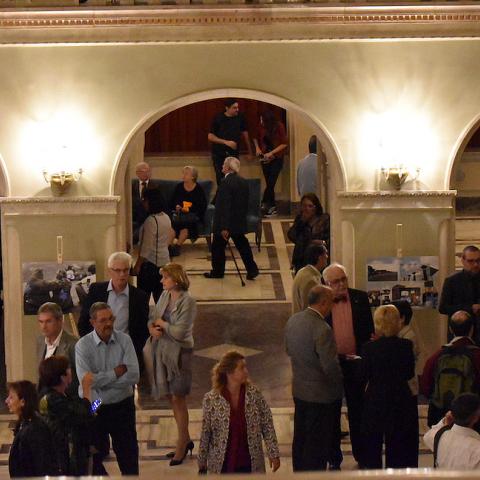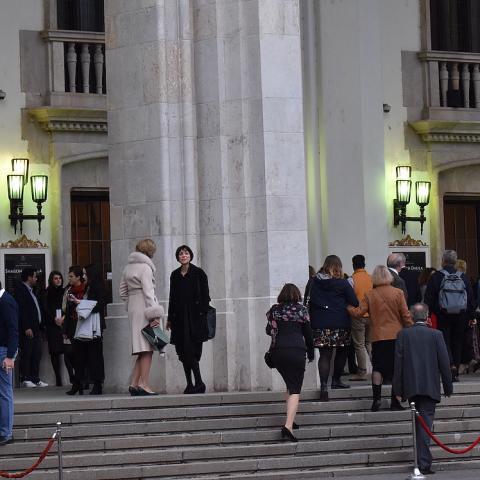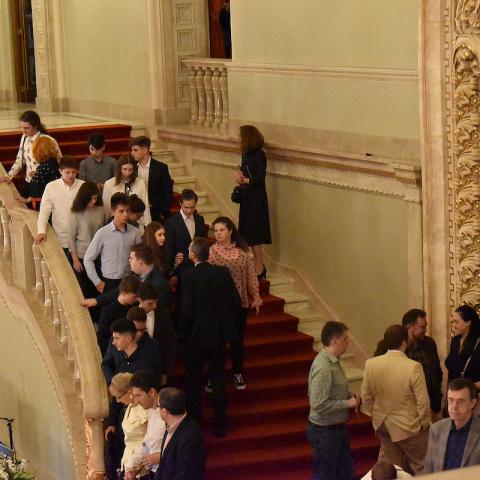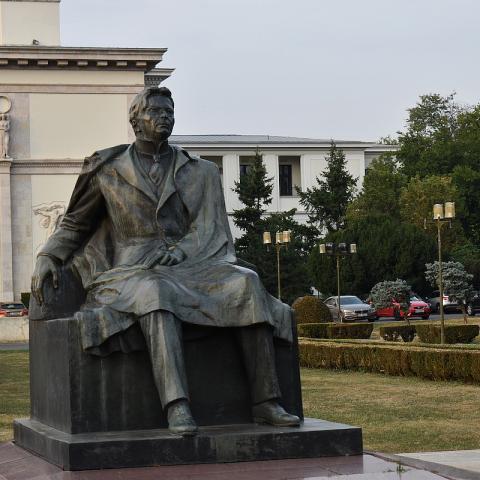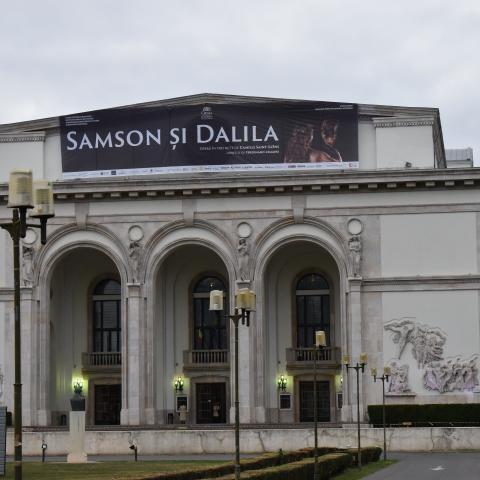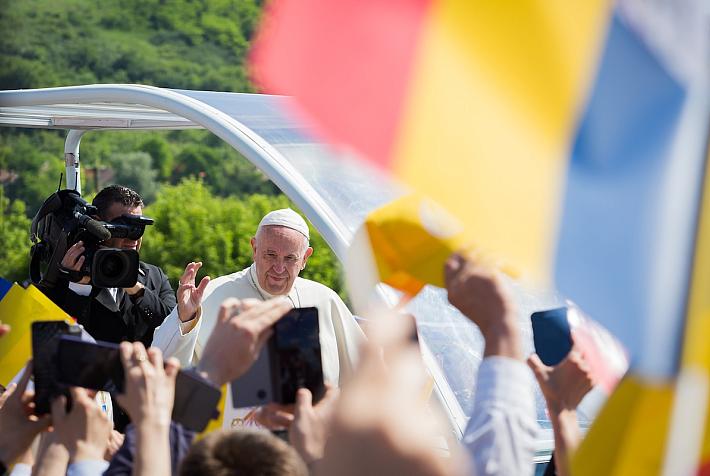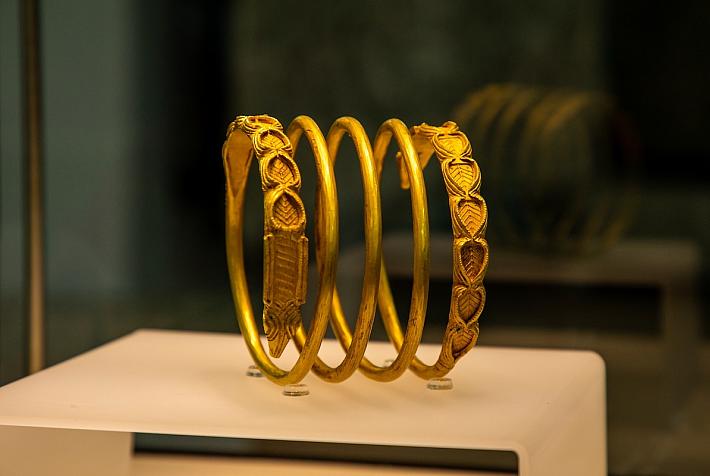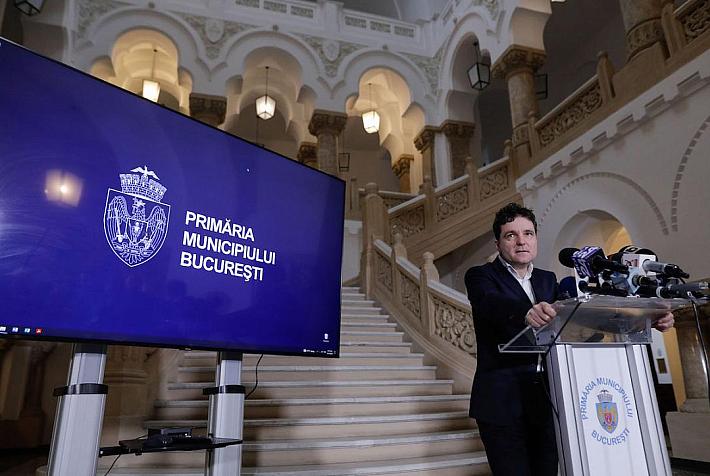"Destination: Bucharest" - A night at the Opera

On Saturday afternoon, only the passing of a trolleybus or the sporadic traffic disturbs the calm that envelops the Opera Park. Several parents have taken their children to the park, an owner is walking his dog, and a few fans of scooter rides are taking a ride nearby. Only the lights turned on at the Opera’s entrance and the banner on the façade let in on the event that is about to begin: the opening of the season with a performance of “Samson and Delilah.”
Shortly before six, everything changes. The cars and taxis bringing the public to the performance start to arrive and the alley in front of the Opera starts filling up with the audience members. The building’s front steps are livened up by the conversations of those who already arrived and are waiting for their friends at the entrance. Text messages are sent and phone calls are made to check for any potential delays. The performance starts at 6:30 and nobody wants to miss the new staging of Saint-Saëns’s opera, with well-known tenor Aleksandrs Antonenko as Samson for the premiere performances.
Even more so given that the opera has not been staged here in a while. In Bucharest, the opera was first presented in 1922, and then in 1927. After a new staging in 1992, and a performance as an opera in concert in the 2006 – 2007 season, the premiere on October 5 is eagerly awaited.
Saint-Saëns worked for very many years on this three-act opera. He started working on it in 1867, planning to compose an oratorio on the subject of Samson and Delilah. Ferdinand Lemaire finished writing the libretto between 1867 and 1869, but Saint-Saëns continued working on the opera until 1876. It premiered in December 1877 in Weimar, on a libretto translated into German, after parts of it and the opera had been received with little interest at home. In time, however, it became a successful work, and the role of Delilah is considered one of the most complex mezzosoprano ones.
The hall is full – veteran opera goers, young people who are just discovering their interest for the genre, or artists. Even though the dress code is no longer a strict one, most audience members go for the elegant look, with pearls, jewelry, scarves and shawls and, at times, a bow tie for the gentlemen, in tune with the elaborate setting of the performance hall.
The lights dim down, the conductor enters the pit, the first notes emerge, the curtain lifts and the first act of the story of Samson and Delilah is unveiled on stage. The work was conceived as a duet between the two main characters and the Latvian tenor Aleksandrs Antonenko and mezzosoprano Orsolya Veress led the audience through the inner tensions of the protagonists of the Bible-inspired story marked by temptation, passion and deception.
An imposing presence, Aleksandrs Antonenko performed on many of the great stages of the world, from the Metropolitan Opera in New York to Wiener Staatsoper or Teatro alla Scala in Milano. Alongside the Chicago Symphony Orchestra, he performed the role of Otello from Giuseppe Verdi’ opera and played the same part at the Paris Opera. Among his future engagements is a new “Otello” production at the Metropolitan Opera, where he performed this year the role of Samson in Saint-Saëns’s opera.
Beside him stood Orsolya Veress, from the Hungarian Opera in Cluj-Napoca. Two of the arias performed by Dalilah are particularly well-known, namely “Printemps qui commence” and “Mon cœur s'ouvre à ta voix.” The latter is one of the best-known recital pieces, something tried and tested during the premiere, when the public offered generous applauses.
The relatively minimal décor was completed with impact by the central screen showing images reflecting the setting of the scenes: the architecture of the square in Gaza where the first act takes place and Dagon’s temple, the desert that serves as a background for the second act, in Dalilah’s house in the Valley of Sorek, or the waterfall accompanying the scene of the bacchanal in the third act. Chromatically, the two protagonists were in opposition: Samson in simple, neutral colors, Dalilah – colorfully-shiny, in line with the opposition between the enslaved people and the world of the merciless philistines.
During the breaks, the views and comments emerge. Opinion exchanges take place and the public discusses the performance of the protagonists, the costumes and décor. “Beautiful, I also liked the direction,” “Antonenko? I’ve seen him in Othello. Divine!”, “I’m interested in the voice here,” “C'était très bon!” – compatriots of French Saint-Saëns are also present at the premiere and the passions presented on stage have contaminated the public in the intensity of the conversations.
Many prefer to step out in the foyer, which turns during the break into the perfect setting for a picture or a selfie. The marble floor, the red carpet, the shiny chandelier can inspire anyone to imagine themselves, for one evening, the protagonist of a glamourous story, just as the world of the opera is.
Possible the best-known piece of the opera, often performed in concerts, the scene of the Bacchanal in the last act brought again on stage the ballet ensemble of the Opera for a scene that was applauded enthusiastically. Samson manages to bring the temple down and the performance ends, making room for lengthy applauses, bravos, and the curtain call.
Upon leaving, an older couple is queuing at the wardrobe: she is smiling, he is humming an aria from the opera that just ended. Like many others, they are leaving the Opera with the beauty of music, romantic and seductive.
To keep in mind:
Tickets can be purchased at the ticket office of the Bucharest National Opera House (ONB) or online at tickets.operanb.ro. The recommended dress code is smart casual. Furthermore, arriving roughly an hour before the performance is also recommended. Those arriving after the start of the performance can take their seats in the hall during the first break. The booklet of every performance, containing further information and photos, can be purchased in the hall. The presence of children younger than 6 is only recommended for performances for children.
Other performances at ONB this season:
Nabucco by Giuseppe Verdi, Cavaleria Rusticană & Pagliacci by Pietro Mascagni - Ruggiero Leoncavallo, Madama Butterfly by Giacomo Puccini, Il trovatore (The Troubadour) by Giuseppe Verdi, Tosca by Giacomo Puccini, Carmen by Georges Bizet, Don Giovanni by Wolfgang Amadeus Mozart, Faust by Charles Gounod, Otello by Giuseppe Verdi, The Swan Lake by Pyotr Ilyich Tchaikovsky, Turandot by Giacomo Puccini, Aida by Giuseppe Verdi, Don Carlo by Giuseppe Verdi, Eugene Onegin by Pyotr Ilyich Tchaikovsky, The Marriage of Figaro by Wolfgang Amadeus Mozart, La Traviata by Giuseppe Verdi, The Nutcracker by Pyotr Ilyich Tchaikovsky.
The calendar of performances is available here.
About the ONB building
The building of the Opera House, included on the list of Bucharest’s historical monuments, was made after the plans of architect Octav Doicescu. Three tall arches frame the façade, embellished with the statues of four muses and two bas-reliefs showing an opera scene and the flight of several dancers. The concert hall is horseshoe-shaped, while the stage, 24 meters wide and 20 meters deep, allows for elaborate performances. In between 2013 and 2014, the building was reconsolidated and refurbished.
From the ONB history
The Romanian lyrical company in Bucharest was established in 1885 and worked for a long time out of the headquarters of other drama or lyrical theaters. The building of the Opera and Ballet Theater of Bucharest, today the Bucharest National Opera House (ONB), was inaugurated on January 9, 1954, with a performance of “The Queen of Spades” by Pyotr Ilyich Tchaikovsky, conducted by maestro Egizio Massini. The following day, the ballet corps delivered the first performance in the new HQ – “Coppélia” by Léo Delibes, with a choreography by Anton Romanovski and Oleg Danovski.
This text is part of a project under the program of promoting the touristic heritage "Destination: Bucharest", carried out by the Bucharest City Hall through the Public Monuments and Touristic Heritage Administration (AMPT).
Photos by Romania-Insider.com for AMPT






